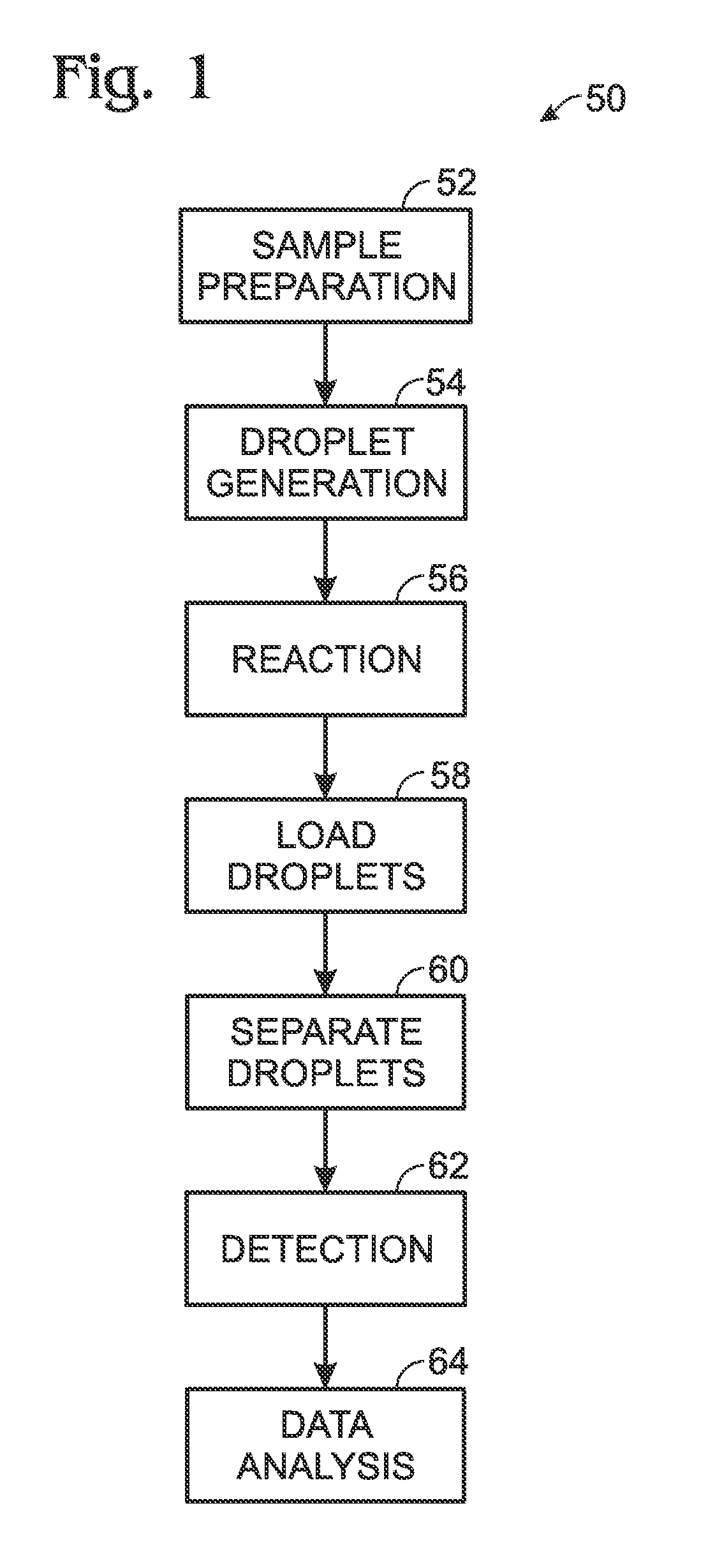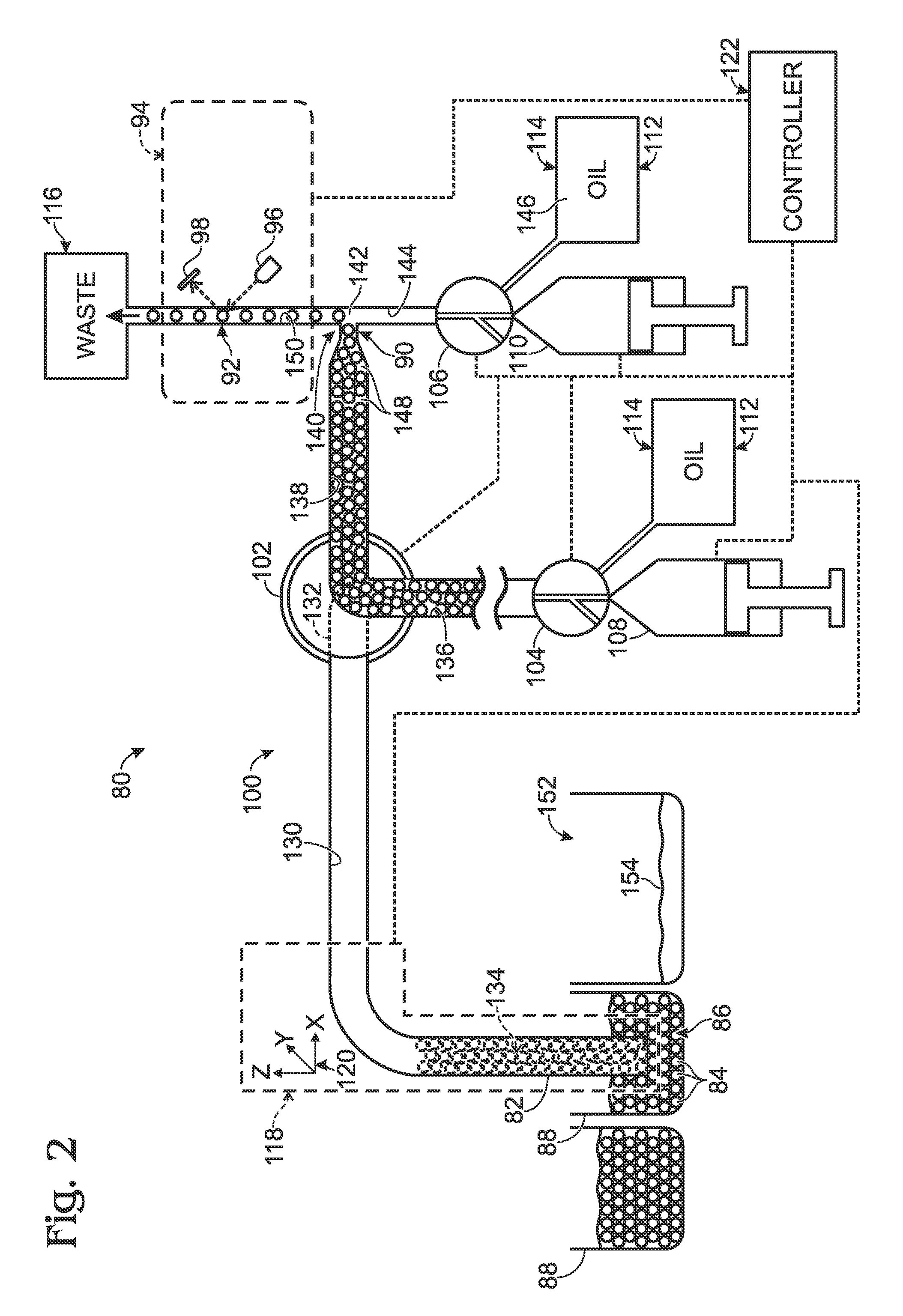Droplet transport system for detection
a technology of droplet transport and detection system, which is applied in the direction of fluid controller, biochemistry apparatus and processes, laboratory glassware, etc., can solve the problems of emulsion-based assays and technical challenges for high-throughput testing
- Summary
- Abstract
- Description
- Claims
- Application Information
AI Technical Summary
Benefits of technology
Problems solved by technology
Method used
Image
Examples
example 1
Exemplary Transport Systems with a Two-State Multi-port Valve
[0051]This example describes exemplary droplet transport systems with a two-state (i.e., two-configuration) multi-port valve to permit switching between two sets of channel connections utilized by three pumps; see FIGS. 3 and 4.
[0052]FIG. 3 shows an exemplary embodiment 170 of droplet transport system 80 of FIG. 2. Transport system 170 may include any combination of the components and features disclosed herein for other transport systems.
[0053]Transport system 170 operates generally as described above for transport system 80, with counterpart elements of system 170 functioning similarly, except where noted below, and being assigned the same reference numbers as those of system 80.
[0054]Emulsions may be held by a multi-well plate 172, which provides containers 88 (i.e., wells) for individual emulsions 86. The droplets of each emulsion may, for example, be thermally cycled as a batch before loading them into transport system...
example 2
Exemplary Transport System with a Coaxial Tip
[0068]This example describes an exemplary droplet transport system with a coaxial tip; see FIGS. 5-9.
[0069]FIG. 5 shows an exemplary embodiment 240 of droplet transport system 80 of FIG. 2. Transport system 240 may include any combination of the components and features disclosed herein for other transport systems. Transport system 240 operates generally as described above for transport systems 80 and 170, with counterpart elements functioning similarly, except where noted below, and being assigned the same reference numbers. However, system 240 may incorporate a number of new components and features as described below, such as a coaxial tip 242.
[0070]FIG. 6 shows a fluidic assembly 244 including tip 242, with the assembly supported by an arm 246 of drive assembly 118. Tip 242 may include an inner tube 248 and an outer tube 250 arranged coaxially. Inner tube 248 may project from the lower end of outer tube 250 to form a nose 252. Nose may ...
example 3
Exemplary Procedures for Using Droplet Transport Systems
[0084]This example describes exemplary procedures and other considerations for using droplet transport systems, such as the system of Example 2, among others. These procedures may include the following classes of operations: (A) pre-plate processing, (B) well processing, (C) post-plate processing, and (D) special operations.
[0085]A. Pre-Plate Processing
[0086]Before the first well (or container) is processed, the following operations may be executed:
[0087]Detector Start.
[0088]The performance of the detector may be sensitive to temperature. For example, the color spectra of the detector LEDs may change with temperature. The LEDs emit heat during use and may require a warm-up period to achieve a stable operating temperature. The LEDs can be turned on in advance of well processing to assure that the temperature and color spectra are stable before processing wells.
[0089]Pump Initialization.
[0090]Since the system can be in an unknown...
PUM
| Property | Measurement | Unit |
|---|---|---|
| internal diameter | aaaaa | aaaaa |
| internal diameter | aaaaa | aaaaa |
| length | aaaaa | aaaaa |
Abstract
Description
Claims
Application Information
 Login to View More
Login to View More - R&D
- Intellectual Property
- Life Sciences
- Materials
- Tech Scout
- Unparalleled Data Quality
- Higher Quality Content
- 60% Fewer Hallucinations
Browse by: Latest US Patents, China's latest patents, Technical Efficacy Thesaurus, Application Domain, Technology Topic, Popular Technical Reports.
© 2025 PatSnap. All rights reserved.Legal|Privacy policy|Modern Slavery Act Transparency Statement|Sitemap|About US| Contact US: help@patsnap.com



